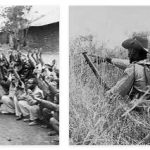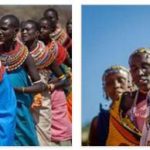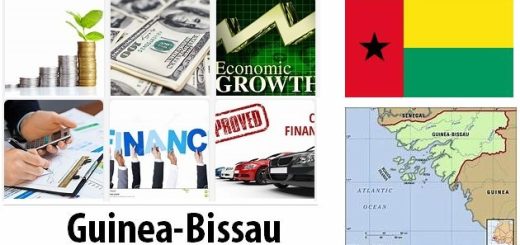Kenya Economy Facts
Economical overview
Kenya is East Africa’s largest economy and is a center for finance, IT technology and transport in the region. The industrial sector is considerably larger and more varied than in neighboring countries. Tourism is an important industry. Growth is partly held back by widespread corruption and dependence on exports of raw materials at pressured world market prices. Agriculture is still an integral part of the economy.
Agricultural products dominate exports, and most Kenyans are engaged in cultivation or livestock management. Agriculture’s share of the economy has declined over time and the sector now contributes less than one-third of gross domestic product (GDP). If you include industry and services related to agriculture, the proportion rises to over half.
- Countryaah.com: Major imports by Kenya, covering a full list of top products imported by the country and trade value for each product category.
The economic development is largely determined by the world market price of tea and coffee, among other things. The government is trying to counteract this by investing in industry. Nevertheless, the manufacturing industry’s share of the economy has remained fairly constant since independence.
The service sector’s share of the economy, on the other hand, has increased. The tourism industry has long been important and the financial sector has grown strongly in recent years, with the help of, among other things, a growing middle class and a construction boom. A large number of banks and financial institutions exist in the country. In addition to the conventional banking system, Kenya has also been at the forefront of new technology with financial transactions via mobile phones. The Nairobi stock exchange more than doubled in value in four years to 2013, and in 2014 the Kenyan government came with its first issue of government bonds.
- Abbreviationfinder.org: Check this abbreviation website to find three letter ISO codes for all countries in the world, including KEN which represents the country of Kenya. Check findjobdescriptions to learn more about Kenya.
During the decade up to 2013, growth averaged just under 5 percent. Given that the population grows by close to 3 percent a year, this means a relatively slow increase in wealth.
It is still significantly better than the years around the turn of the millennium. At that time, growth was record low, just under 2 percent, due to financial neglect, galloping corruption and recurring drought. The standard of living fell for many Kenyans. After the change of power in 2002, the government took measures to liberalize the economy and fight corruption.
The biggest threat to the economy now appears to be terrorist acts in the country and the unrest in the region that threatens the important tourism industry (see also Foreign Policy and Defense).
Kenya has received significant assistance since independence in 1963. Donors include both individual countries, especially the US and EU states, and international lending agencies. On several occasions since the 1990s, the country’s most important aid and lenders have halted large part of the payments due to mismanagement, lack of democracy and the failure to liberalize the economy. In early 2011, the government adopted a new reform program supported by the International Monetary Fund (IMF), including new tax legislation, stricter budgetary control, investment in infrastructure and investments in making the new constitution fully operational. Kenya received support from the IMF with $ 750 million over three years. But problems with corruption and political instability remain, prompting aid and lenders to continue supporting the country.
FACTS – FINANCE
GDP per person
US $ 1 711 (2018)
Total GDP
US $ 87,908 million (2018)
GDP growth
6.3 percent (2018)
Agriculture’s share of GDP
34.2 percent (2018)
Manufacturing industry’s share of GDP
7.7 percent (2018)
The service sector’s share of GDP
42.7 percent (2018)
Inflation
5.6 percent (2019)
Government debt’s share of GDP
60.1 percent (2018)
External debt
US $ 26 424 million (2017)
Currency
Kenyan Schilling
Merchandise exports
US $ 5,792 million (2017)
Imports
US $ 15,994 million (2017)
Current account
– US $ 5,018 million (2017)
Commodity trade’s share of GDP
27 percent (2018)
Main export goods
tea, cut flowers, coffee, oil products, cement, fruits, vegetables
Largest trading partner
Uganda, China, India, Saudi Arabia, United Arab Emirates, Netherlands
2014
December
Organizations are accused of helping terrorists
The authorities deregister over 500 voluntary organizations. The government freezes their bank assets and withdraws work permits for foreign staff. As a reason, it is stated above all that they did not manage their accounts. 15 of the organizations are accused of helping to fund terrorism.
New team meets resistance
The law comes into force after President Kenyatta signed the law on December 19. The opposition, civil rights organizations and the media announce their intention to go to court to try to get the law repealed.
Bills are being submitted to reduce terror
Parliament adopts new and controversial anti-terrorism legislation after heated debate. It strengthens the president’s powers over security issues. Authorities are given the right to keep terror suspects in detention for up to one year, the intelligence service is given the right to intercept communications without having to seek permission from the court, and journalists must have police permits to publish domestic security articles. The bill has been harshly criticized by human rights organizations and the opposition who accuse the government of wanting to create a police state. A few amendments are approved by Parliament a week later in tumultuous forms, where fights break out and an opposition representative throws books at the President. On the President’s order, a police officer is called in to escort several members out of the building.
The president’s trial will not end
Prosecutors at the International Criminal Court (ICC) say that the evidence is not sufficient to establish Kenyatta’s guilt “beyond all reasonable doubt” and it is thus clear that there will be no trial against him (see ICC trials after the 2007 election).
The Minister of the Interior and the Chief of Police are dismissed
President Kenyatta, who has been criticized for not doing enough to strengthen security in the country following the 2013 Nairobi terrorist act, dismisses Interior Minister Joseph Ole Lenku and the country’s Police Chief David Kimaiyo. Former General Joseph Nkaissery is appointed new Minister of the Interior.
Attack on Christians
Somali Islamist group al-Shabaab takes on a new attack when at least 36 workers are killed near Mandera. As in November, violence is directed against Christians.
November
Bus passengers killed
A group of armed men kill 28 passengers on a bus in Mandera, northern Kenya. The victims are Christian, while Muslim passengers are spared. The Somali Islamist group al-Shabaab takes on the blame for the act.
Raids against mosques
The police raided several mosques in Mombasa and arrested a total of over 350 people suspected of being linked to extremist Islamist groups. The raids lead to unrest.
Muslim minister murdered
A faithful Muslim minister, Salim Bakari Mwarangi, is shot dead in Mombasa as he is on his way home from evening prayer. It is unclear who is behind the deed.
October
Leader for MRC is arrested
Omar Mwamnuadzi, leader of the separatist movement MRC, is arrested in Mombasa. Among other things, he is accused of having held meetings that must have violated the law. According to the police, there are close contacts between the MRC and the Somali Islamist group al-Shabaab
Trial against Kenyatta starts
Kenyatta becomes the first sitting head of state to appear before the International Criminal Court (ICC). After that, he returns to Kenya where he is greeted by cheering followers.
September
The president’s trial is postponed
The Chief Prosecutor of the International Criminal Court (ICC), Fatou Bensouda, decides to postpone the trial against Kenyatta indefinitely. As a reason, she states that there is no evidence, among other things, several witnesses have taken back their testimonies.
August
Anti-terror force is accused of abuse
In a report by Human Rights Watch , the Kenyan Anti-Terrorist Force (ATPU) is accused of serious abuse in connection with interventions against terror suspects. Even the riot police GPU and the national intelligence service are also suspected of involvement in some of the abuses (see Political system).
Agreement with China on port
President Kenyatta signs an agreement with a Chinese company to begin construction of a large new port at Lamu (see also Communications).
July
Tourists sheltered
Seven people are killed when a tourist bus on the way to the island of Lamu is shot as well as the police car that comes to the scene of the attack.
Manifestation against the government
Thousands of people hear opposition leader Odinga’s call for protest demonstrations against the government on July 7.
Marketplace attacked
Nearly 30 people are killed when heavily armed men attack a trading post in the village of Hindi and a police station in the village of Gamba, both located in the coastal area. al-Shabaab claims to be behind the death, but police say they have been executed by the regional separatist movement MRC.
June
Villagers killed
A new attack occurs in a village about 15 km from Mpeketoni, and at least five people are killed. This time the perpetrators use machetes and knives.
Harsh criticism of police and military
The criticism is growing against the work of the police and the country’s law firm demands that the chief of police and the Minister of the Interior Joseph Ole Lenku resign. Lenku has also received harsh criticism for how the police and the military handled the crisis around the Westgate gallery (see September 2013).
Not clear who is behind the major terrorist attack
About 50 people are shot dead when armed men attack the police station and hotel in the town of Mpeketoni near the island of Lamu. al-Shabaab takes on the blame and says it is a revenge attack for Kenya’s role in Somalia as well as a protest against the police’s increasingly brutal treatment of Somalis in Kenya (see Foreign Policy and Defense).
The day after, the village of Poromoko near Mpeketoni is subjected to an attack and at least 15 people are killed. In a televised speech to the nation, President Kenyatta says all evidence indicates that they were carried out by a local Kenyan group and not by Islamists. According to the security service, al-Shabaab is the one who performed the killing.
Muslim terrorist critic killed
A leading moderate Muslim minister, Mohammed Idris, is shot to death when a mosque in Mombasa. Idris had criticized al-Shabaab and demanded that the authorities intervene with the group’s financiers in the area.
May
State measures against terror are criticized
Amnesty International criticizes the authorities for efforts that have resulted in thousands of Somalis being arrested and hundreds sent back to Somalia on arbitrary grounds. Amnesty emphasizes that the arrested Somalis have not been charged with terrorism-related crimes. Several observers believe this may have played al-Shabaab in their hands, among other things, by making it easier for the Islamist group to recruit new members.
Nairobi in focus for al-Shabaab
Fuad Mohamed Khalaf, who has a leading position in the Somali Islamist group al-Shabaab, says the militant group is now concentrating its campaign on violence in Nairobi.
Students in protest
Student protests against higher university fees lead to clashes between students and police in Nairobi. Protests against the fee hikes also occur at other Kenyan universities.
New assaults are killing lives
New attacks occur in Mombasa, Nairobi and northern Kenya, with a total of over 20 dead.
April
Car bomb in Nairobi
Two suspected terrorists and two police officers are killed when a car bomb explodes outside a police station in the capital Nairobi. It was, according to AFP, the first car bomb attack in Kenya since the attack on the US embassy in 1998.
Muslim minister killed
A Muslim minister, Abubakar Shariff Ahmed, is shot dead at a bus stop in Mombasa. He has previously been accused of recruiting new members for al-Shabaab.
March
Terrorism in Nairobi
At least six people are killed at a bus stop in Nairobi when an explosive charge is thrown at them. It is unclear who is behind the act, but the authorities take it as a pretext to crack down on illegal immigrants. In the following days, around 4,000 Somalis are arrested.
The government fears for the safety of refugees
The government orders all Somali refugees living outside the refugee camps to return to Dadaab and Kakuma. This is motivated by concerns about terrorist attacks. The decision affects about 100,000 Somalis, many of whom work in the cities.
Legal process against the government
A legal process is then initiated by some rape victims, supported by human rights organizations, sued the Kenyan government for failing to protect the police in connection with the violence after the 2007 elections.
Attacks on crutches
At least six people are killed in an attack on a church in Mombasa on March 23.
Journalist is extradited to international court
A Kenyan court is clear that journalist Walter Barasa can be extradited to the International Criminal Court (ICC). He has been accused of trying to bribe witnesses in the case against William Ruto (see October 2013).
Ministerial salaries are lowered
President Kenyatta announces that he and Vice President Ruto cut their wages by 20 percent. At the same time, all ministers get their salaries reduced by 10 percent. The purpose is to save money.
February
Refugees return
Between 80,000 and 100,000 Somalis are said to have returned to Somalia from the Dadaab refugee camp (see November 2013).
The raid provokes anger at Muslims
Police carry out a raid on mosques in Mombasa which they fear is a detention for young militant Muslims. It triggers violent protests for several days in a row. More than 100 people are arrested and accused of being members of the Somali Islamist group al-Shabaab. The raid and the arrests are provoking anger among Kenya’s Muslim population, most of whom stand for more moderate Islam. Prosecutions are brought against around 70 of those arrested at the mosques and suspected of being members of al-Shabaab.
January
False payrolls are corrected
President Kenyatta orders a review of all public sector payrolls to wipe out any “ghost workers”, deceased, retired and others who still receive pay even though they are not working. According to the president, an initial preliminary examination by some ministries showed that the equivalent of over $ 800,000 was paid to such ghost workers.













